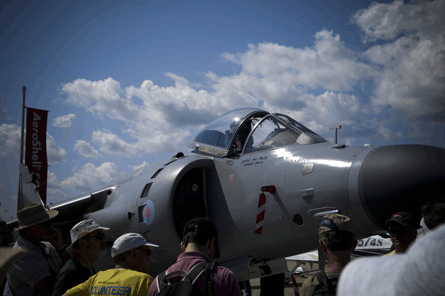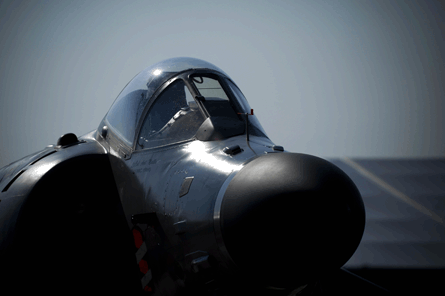Not long before the UK Royal Navy decommissioned the last British Aerospace Sea Harrier in March 2006, Maryland resident and aircraft mechanic Christian Vlahos received a phone call from a close friend.
Art Nalls, calling from England, immediately got to the point.
"He said, 'Christian, I want to buy a Harrier,'" Vlahos recalls nearly four years later. "I was like, 'As in, a 'Harrier'-Harrier?!'"
As unusual as the conversation may seem, it was not entirely out of character for Nalls. A former US Marine Corps test pilot-turned-real estate-millionaire, Nalls has an eccentric streak. Not only had Nalls restored - with Vlahos' voluntary assistance - an assortment of Yakovlev and Aero Vodochody aircraft to fly on the airshow circuit, Nalls had once owned the Guinness record for designing and riding the world's tiniest bicycle, standing about 12.7cm (5in) high.
 |
|---|
© BillypixArt Nalls' privately owned Sea Harrier was a star attraction at the EAA AirVenture fly-in in Oshkosh, Wisconsin, in July |
Nalls wanted to know if Vlahos, a former US Navy F/A-18 mechanic, could help him restore the world's only privately owned - perhaps "only" for a good reason? - Sea Harrier.
"If you want to buy it, I'll make it fly," Vlahos assured him, knowing something of the challenge involved. The Sea Harrier evolved in the late-1970s from the Hawker P.1127, which achieved its first flight 50 years ago, becoming the only successful operational vertical and short take-off and landing (V/STOL) fighter in Western service.
"I love this airplane. I want to get it," Nalls replied to Vlahos.
Nalls flew Harriers in the 1980s, but his motivation was not merely nostalgic. The self-made millionaire sensed a business opportunity. The Marines' official Harrier display team is the most requested aircraft among US airshows, Nalls said in an interview.
"I [bought the Sea Harrier] as a financial decision," he says. "The marines get more requests for the Harrier every year than the Thunderbirds and Blue Angles combined."
But Nalls knew he could not restore the Sea Harrier by himself. Until he secures a sponsorship deal, which still eludes him, he needs volunteers to help him realise his goal.
Vlahos remembers that Nalls gave him one last opportunity to say no on the fateful phone call in 2006. Before hanging up, Nalls asked one more time: "Are you sure we can do this?"
"Absolutely," Vlahos said.
So began an odyssey of restoration and flight tests that would consume Nalls, Vlahos and 25 volunteer mechanics for two years. Along the way, the team would encounter serious obstacles, including a nose-gear collapse after an in-flight hydraulics failure that forced Nalls to perform a vertical landing in Harrier for the first time in 16 years during an emergency. A fire would consume a single, critical component that costs $250,000 to replace.
Reflecting on their achievement, Nalls remains in "disbelief that we even did it." Surprisingly, he encounters people even within the aviation community who brush off the complexity and audacity of the restoration project. "They say, 'Anybody could have done it. You put it together, you flew it'," Nalls says. "They have no idea of the technical challenges."
MOTIVATION
It may seem like a curiously altruistic affair for Nalls' support team. After all, this group of aircraft mechanics voluntarily donates hundreds of hours every year for Nalls to realise his dream to again fly the Harrier, a jet he came to love during his Marine service.
Vlahos, the full-time owner of Chesapeake Aviation Services, has several theories for what keeps the group working on the Sea Harrier. Some are motivated by the desire to prove doubters wrong, others want to part of something bigger than they are, while still others hope for personal employment. For Vlahos, however, the reason is more personal.
"To be perfectly honest, the reason is Art," Vlahos says. "Being the person that he is, he does anything in the world for anybody. He's the most giving, most kind person you'll ever meet in your life. I'm going to do what's in my power to make this airplane fly."
That spirit may be what keeps the project still going after four years. When the Sea Harrier arrived in early 2006, its condition seemed bleak.
 |
|---|
© Billypix |
"You're looking at this airplane and you're thinking 'whoa'," Vlahos says. "It's probably overwhelming at this point. The aircraft is sitting on three different stands in pieces."
There were many unknown variables about the Sea Harrier. Nalls' experience with the AV-8B Harrier II was of little help, as the aircraft are "entirely different animals", Vlahos says.
"Everything is more critical with the Harrier. You're talking higher speeds, reactionary control nozzles at the nose, tail and wingtips, tubing that carriers the hot air for the nozzles," he says. "If there is the slightest scratch or dent in these tubes it causes a hot spot that burns everything in the vicinity."
Nalls bought the Sea Harrier from an aircraft broker who guaranteed the surplus aircraft was completely intact. However, Nalls says, they discovered much of it needed to be restored and major parts and systems needed to be re-engineered to make it flyable. Among the items were the pitot-static system, the emergency blow-down system for the landing gear and ejection seat installation.
"So much stuff was missing from the airplane," Nalls says.
The restoration project was also slowed by lack of availability of parts. Standing up a private supply chain to support a Sea Harrier requires as much as pluck as cash. Nalls recalls a spare-hunting trip to Pensacola NAS, Florida. At the time, he was desperately short of spare gas turbine starters, a system as costly as it is mechanically fickle.
"We found one in the trash in Pensacola," Nalls says. "The people there they were throwing that away. I said, 'Can I have that?' We put in the pack of our pick-up truck."
Piece by piece, the aircraft was restored and returned to flyable status. But setbacks delayed the pace of the team's progress. The lowest point may have come when the primary hydraulic system failed on Nalls' second flight. The nose landing gear dropped, but - unknown to Nalls - failed to lock, crushing the nose after it collapsed.
"When it got tough we kept pushing," Vlahos says. "Everything was a small problem up until that [hydraulic system] failure. When he got it safely on the ground, we're looking at it. It's a twisted wreck sitting on the tarmac at Patuxent River. Everybody knew what this meant to Art. I just looked at Art and said, 'We'll get it back up'."
Nalls, however, did not show any signs of despair. With the damaged Sea Harrier transported by truck from Patuxent River to Vlahos's hangar, Nalls rode in the open cockpit dressed up as Santa Claus, waving to confused onlookers.
CROWD FAVOURITE
As thousands of air show attendees across the USA already know, Nalls eventually restored the Sea Harrier, received FAA certification and a type rating as a pilot. Nalls' Sea Harrier is now a favourite on the US airshow circuit, with Nalls completing each show with a 30e_SDgr nose-down "bow" to the audience.
"The first time I tried [the bow] it looked anaemic," he says. "You can't even see the nose move a little bit. Then, this Brit who has since become a friend emailed. He said, 'Mate, your bow looks horrible! You don't know how to do it.' He told me the procedure. I'm just stupid enough to go out and try that."
"It was outstanding," says Wayne Boggs, air boss of Experimental Aircraft Association's AirVenture fly-in at Oshkosh, where Nalls performed in July. Nalls "did a great job".
Nalls' Sea Harrier may join the air show circuit again next year, or it may not. Nalls was interviewed by phone while en route to a doctor's appointment, a follow-up visit after undergoing knee replacement surgery.
"It could end in the next 15 minutes," Nalls says. "With this knee replacement I could lose my medical" clearance.
Even if Nalls is sidelined, the Sea Harrier now has a back-up pilot - Joe Anderson, a retired USMC major general. But the Sea Harrier will need more than a pilot to keep it flying.
"If we can stay ahead of the curve here with life-limited parts then it's just maintaining everything else, which requires money, which is becoming a scarce thing," Vlahos says.
Nalls agrees: "We've done all of this relatively on a shoestring [budget]. If we had somebody who showed up with a fair amount of money - we're talking tens of millions of dollars - we need to hire volunteers as full-time maintainers."
As always, Nalls is taking an optimistic approach to the future. "We could be one phone call away," he says. "There could be an aviation enthusiast out there who says, 'I like these guys. I like their spunk. I like what they've been able to do'."
Source: Flight International
















